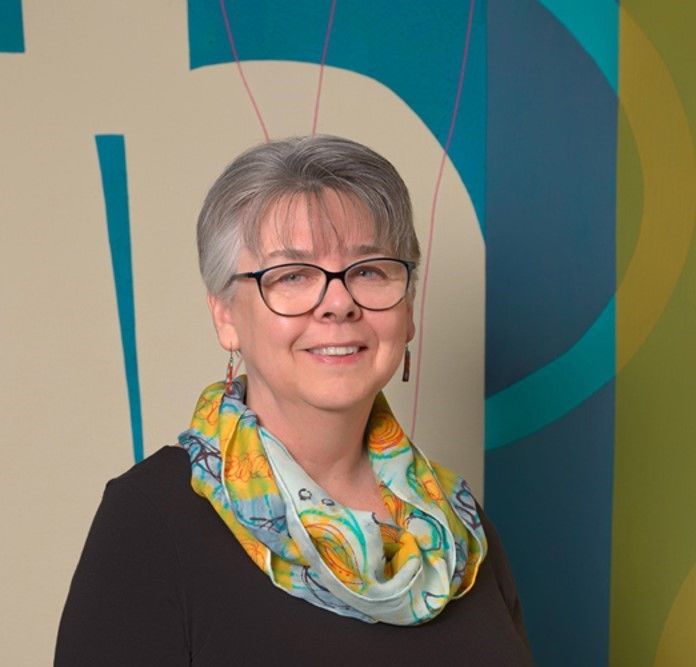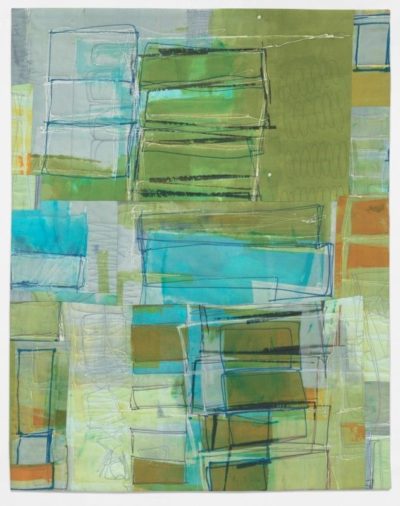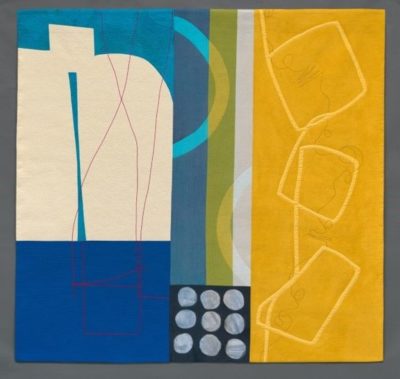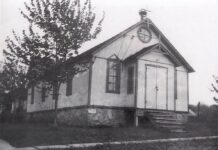
Like so many kids, as a toddler Karen Schulz had a blanket that went everywhere she did.
“I can still remember running my fingers along the satin binding of the blanket,” she says. Once, she thinks, it was white, but she remembers it as a dingy greige color.
At 5, on entering first grade, she still needed that transitional comfort object. “But my parents were really smart about it,” she recalls. “They cut away one four-inch square of my blanket at a time. So it was a gradual separation. Then one day, I just left the last square behind somewhere, and that was that.”
Or maybe it wasn’t. As a professional contemporary art quilter, Schulz spends her days handling fabric, dyeing it, cutting and shaping it, piecing it together into stunning abstract designs. She uses cloth and thread — and now paper and paint — the way a trained abstract expressionist painter does, considering line, shape, color, weight and texture.
Locally, she has shown her work at Glen Echo Park, Black Rock Center for the Arts, Waverly Street Gallery, the Ratner Museum and Strathmore Mansion. And she takes commissions.
The Silver Spring resident learned to sew from her grandmother on a treadle sewing machine. “She was a very accomplished seamstress and made beautiful clothing. She always made her own patterns,” Schulz says, “and she loved making fancy dresses for her granddaughters. These dresses always came surrounded by an air of drama: We had to be blindfolded for the fittings because she didn’t want us to see the dress before it was in its final state.” That lesson stayed with Schulz: “Don’t show a quilt until it’s finished.”

While she went on to sew many of her clothes in college, Schulz made her first quilt as a gift for her younger sister. “I took myself to the Woolworths down the street and bought a book on how to make a quilt. I made so many mistakes on that thing, but I hand-quilted it on a homemade frame that at the time took up the entire living room where I was living. We had to crawl on our hands and knees underneath the frame to get to the other side of the room!”
But Schulz was hooked. Quilting became a refuge during her career as a clinical social worker for children, adolescents and families.
“Quilting was for my own pleasure and for family,” she says, “until I started making them for the wall.”
As her quilts grew in size, she made discoveries at various workshops, classes and quilters meetings that set her on course to study seriously with contemporary fabric artists and experiment with new techniques.
From master quilt maker and teacher Nancy Crow, Schulz learned that contemporary quilting “is grounded in composition. That undergirds everything that you do from the very beginning.”
This understanding inspired her to investigate color theory, line, design and structure — values that painters use in their work. “It’s all about compositional discovery,” she says. “I had never taken an art course in my life. I was 53 and decided … making quilts is very time consuming. If I’m going do this, I want them to be the best I’m capable of. I want them to be the most beautiful, the most interesting and I was willing to put in the work because I love it.”

Objects in This Mirror, 67 x 70 inches, 2018, fiber
Photo by QuickSilver Photographers/Mark Gulezian;
That has led to what Schulz calls a wet studio in her basement, where she custom dyes her fabrics, usually a dense cotton, to get the theexact colors and shadings she desires for each project or commission. “I want my cloth to reflect me as an artist,” she says.
Upstairs, her sewing studio contains a Bernina sewing machine with a larger throat plate designed for quilting, though she doesn’t use a long-arm machine because of the expense and space it requires. “I do all my own quilting, always have. In my upstairs studio I design, cut, sew.”
In recent years she said she has become frustrated with the limits of sewn quilts when it comes to complex images, since she uses solid-colored pieces. “When you sew a line, you can only get so complex,” she explains. “If I’m trying to get a really expressive line, you’re limited. It’s not like a pencil or a paint [brush].”
Schulz has become known for her creative use of line in her work, which she credits to a specific stitch. “I do a lot of what’s called couching. It’s sewing … yarn or a thicker thread on top with a zigzag stitch.”
That technique is difficult, and Schulz still finds certain things she can’t do with single lines and couching. “That propelled me into [exploring] mixed media on paper to investigate line quality.”
Her most recent works express her painterly eye in acrylic and mixed media pieces on paper. These pieces lend themselves to deeper investigations in color, shape, texture and line.
Reflecting on her evolution as an artist from her childhood love of a cuddly blanket to sewing lessons with her grandmother, to a decades-long practice as a psychotherapist with quilting as a hobby, Schulz says, “Is it therapeutic for me to create art? Well, absolutely. But that’s not the reason I do it.”
She is a self-created artist.
“I don’t make art to put in my closet or just for my own benefit or to feel better,” she insists. “I want what I make to be seen.”
For information on Karen Schulz’s quilts and mixed media on paper, visit karen-schulz.com




